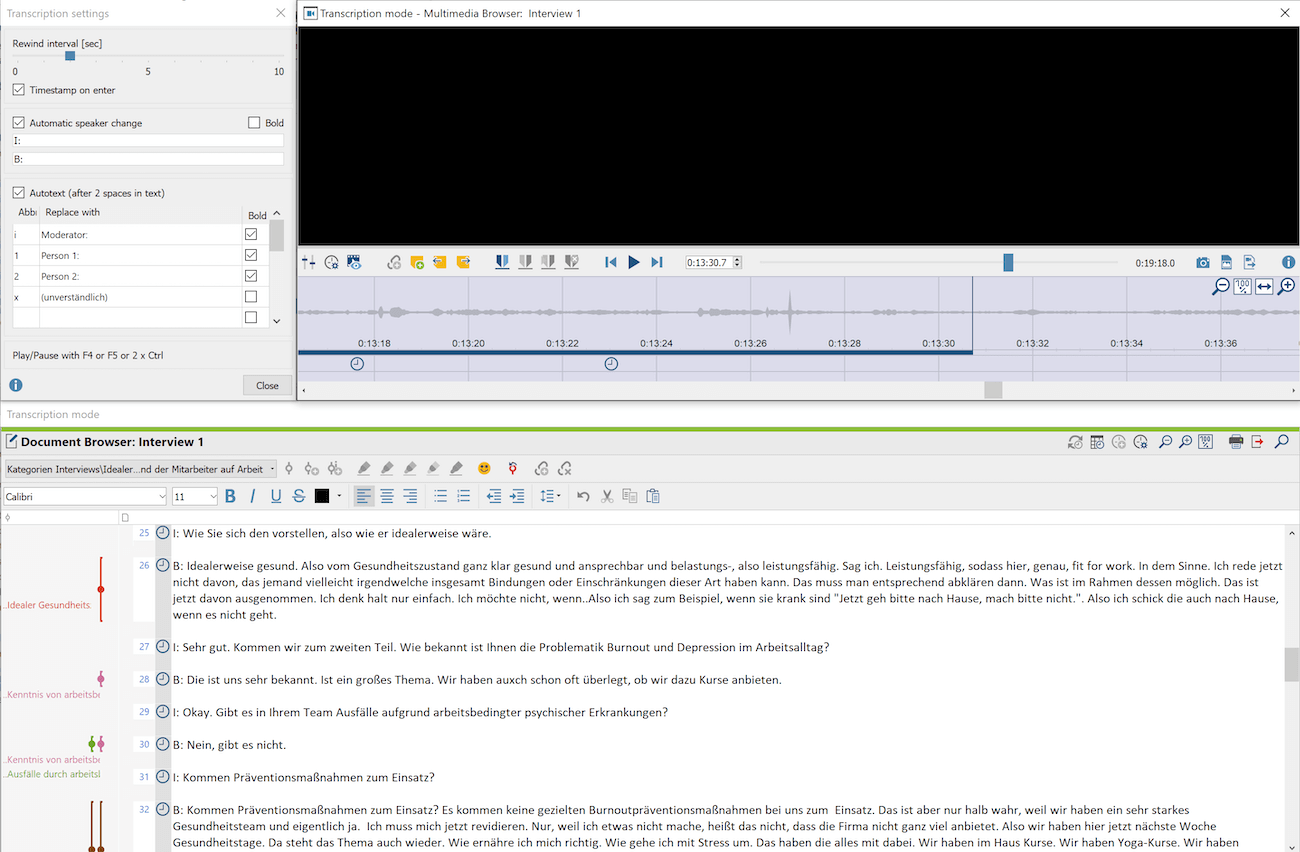Guest post by Maximilian Sprößig.
In the rapidly and continuously changing workplace, employees are being exposed to new work requirements every day. Some of these changes are, for example, the tertiarization of our society, the informatization of the workplace, the acceleration of production, service and communication processes, and the emergence of entirely new forms of work. These changes can lead to an increase in work-related stress and even crises, both professional and personal. How well a person deals with these issues comes down to resilience. To avoid experiencing depression and burnout (which are sadly common outcomes of work-related stress), promoting resilience in employees can be a way of helping them cope with stress and other work-related issues.

Due to an increased number of work-related conditions, the task of workplace health promotion is the conception and implementation of measures to strengthen health resources. It is a good idea to invest in the development of psychological capital and promote resilience in employees as a preventive measure. Resilient employees are more emotionally stable when faced with crises, more open to new experiences, more flexible in the face of change, and their performance in stressful environments is improved.
Research has led to the presumption that it is possible for companies and organizations to support and nurture resilience through different leadership styles or through their influence on the work environment. But how motivated are leaders to invest in non-measurable attributes with – at least in the short and mid-term – no guaranteed outcomes?
To investigate to what extent leaders are in fact motivated to do this, I conducted nine interviews with leaders from different industries, mostly in human resources departments due to their natural knowledge and experience with the topic of resilience. These interviews were then transcribed and analyzed with MAXQDA.
How to quickly and easily transcribe research data
Transcribing my interview audio files with MAXQDA
Before I came across MAXQDA, I always needed several different programs to transcribe my data: one to play the audio and at least one other to type the text. But there was no need for that anymore once I had discovered MAXQDA because it lets you do all these things in one place.
To transcribe the collected data, the first step was to import it into MAXQDA. MAXQDA’s Import tab provides numerous functions for importing different types of data. When you start a new project, the tab is automatically opened. I simply selected the corresponding option for the data I wanted to import, and MAXQDA imported the data into MAXQDA’s “Document System” window.
After I had imported my data, I right-clicked on the relevant file and chose “Transcribe Audio File”. MAXQDA’s Multimedia Browser then opens with many different options that optimize the transcription process then opened, as shown in the screenshot below (Figure 1).
Figure 1: Transcribing Interviews in MAXQDA’s Transcription Mode
Shortcuts like the F5 button for easy pausing and playing the audio, the Automatic Speaker Change when you press Enter, or the rewind interval to jump back and check what you typed – all these functions increase the efficiency of the transcription process. After I had finished my transcriptions, I closed Transcription Mode by simply clicking the red x, and could get started on the analysis stage right away. Each transcription I completed as part of my research barely took a tenth of the time I had needed before I discovered MAXQDA.
Paraphrasing the transcribed interviews
A left click on the transcribed file reveals the transcription protocol. If you need to verify the text, the time stamp on the left side allows you to jump to the corresponding point in the audio.
To fulfill the purpose of my research and get the information I needed about leaders’ motivation to promote employee resilience, my next step was to extract the essence of the replies of my interview subjects. MAXQDA’s tool for this task that I used is the Paraphrase function, which you can find in the ribbon menu under the Analysis tab.
Figure 2: Paraphrasing interviews with MAXQDA 2018
When you select a section of text in Paraphrase Mode, MAXQDA opens a separate window where you can write paraphrases aligned with the original text (Figure 2). These are displayed right next to the original passage, which meant I could keep track of my analysis during my analysis process. Once I had I finished this step, I was also able to categorize these paraphrases. I could thereby develop codes that I could then use for all the interviews, which later allowed me to visualize relations within different interviews.
Using the Summary Grid for higher-level analysis
I soon noticed that some of my paraphrases were related to each other and that the single step of paraphrasing was not enough. MAXQDA offers the Summary Grid as a solution for deeper analyses. This feature can also be found in the ribbon menu under the Analysis tab. With this tool, paraphrases with the same content can easily be summarized. By clicking on one of the intersections between documents and categories, you can see all the corresponding paraphrases and can summarize them from here.
Because my interviews were open interviews, my subjects broached some topics at different stages in the discussion, which made this tool extremely valuable. Once I had used the Summary Grid, I was not only able to answer my research question with respect to one interview but also – with the further help of Summary Tables, another MAXQDA feature – get a quick overview over all the relevant statements made by all the interview subjects.
Visualizing my analysis results with MAXQDA
MAXQDA offers you a range of tools to detect relations within categories. The Code Relations Browser, for example, displays overlapping codes in chosen documents. This makes it easy to quickly identify possible connections between codes. In addition, the Browser’s matrix is interactive, meaning that by clicking on one of the squares (or circles), MAXQDA displays the corresponding segments in the “Retrieved Segments” window. This also allows you to verify the quality of your code system when it comes to existing assumptions regarding the relationship between codes (e.g. from the available literature on a topic).
For my research, I selected the codes developed from my paraphrases in the hope of finding some correlations I had predicted in advance. Eventually I found a connection between “Knowledge of work-related psychological conditions” and “Failures due to work-related psychological conditions” – in other words, it wasn’t simply a presumption but actually happened to my subjects in their work-life reality as well.
MAXQDA’s MAXMaps feature helped me visualize code relationships and, more specifically, code clusters. I was able to calculate the frequencies of code co-occurrences for the interviews and generated a table, which was convincing on its own. Since it was also quite difficult not to lose track of all my data, I chose to visualize the relationships among the codes with the highest frequencies of co-occurrence. These results were quite useful, as I could use them for the nomothetic approach of my analysis.
Figure 3: Code Co-Occurrence of the interview codes after paraphrasing
Conclusion
After analyzing the data, I was able to ascertain a fundamentally positive attitude of the interviewees to the topic. However, due to the existence of already-applied preventive measures for work-related psychological conditions, and the fact that the promotion of resilience should happen proactively and preemptively, not reactively, the motivation to act is to be described as… restricted.
Nevertheless, the issues of burnout and depression in the daily work routine have become increasingly relevant for companies, and the reaction to real cases can help to prevent further employees suffering unnecessarily. Managers are partially aware of the importance of their role in resilience development but need to focus more on leadership styles that promote resilience – not just on already established training programs and information events.
The increasing occurrence of psychological conditions in the workplace means taking action is necessary, not least because it can improve productivity and decrease absenteeism, and the motivation is certainly there. Taking action would also fulfill the task of promoting workplace health as mentioned in the introduction, in order to actively strengthen the health resources of employees.

There is still room for improvement in Germany’s work environment. With some initial steps having already been taken and with leaders’ motivation to change their approach, further requirements are set to lead German business towards a healthier future. This will take time though and some trust that the journey will end positively.
About the Author
Maximilian Sprößig is a current diploma student of the Technical University Dresden, Germany. He is interested in human resources development and focuses his research on the promotion of resilience in the workplace. During his studies, he conducted several research projects and his thesis with MAXQDA.




 Maximilian Sprößig is a current diploma student of the Technical University Dresden, Germany. He is interested in human resources development and focuses his research on the promotion of resilience in the workplace. During his studies, he conducted several research projects and his thesis with MAXQDA.
Maximilian Sprößig is a current diploma student of the Technical University Dresden, Germany. He is interested in human resources development and focuses his research on the promotion of resilience in the workplace. During his studies, he conducted several research projects and his thesis with MAXQDA. 


